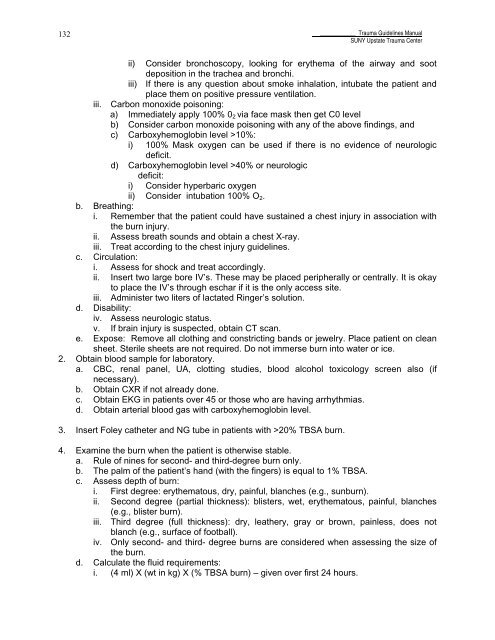Trauma Guideline Manual - SUNY Upstate Medical University
Trauma Guideline Manual - SUNY Upstate Medical University
Trauma Guideline Manual - SUNY Upstate Medical University
You also want an ePaper? Increase the reach of your titles
YUMPU automatically turns print PDFs into web optimized ePapers that Google loves.
132____________ <strong>Trauma</strong> <strong>Guideline</strong>s <strong>Manual</strong><strong>SUNY</strong> <strong>Upstate</strong> <strong>Trauma</strong> Centerii) Consider bronchoscopy, looking for erythema of the airway and sootdeposition in the trachea and bronchi.iii) If there is any question about smoke inhalation, intubate the patient andplace them on positive pressure ventilation.iii. Carbon monoxide poisoning:a) Immediately apply 100% 0 2 via face mask then get C0 levelb) Consider carbon monoxide poisoning with any of the above findings, andc) Carboxyhemoglobin level >10%:i) 100% Mask oxygen can be used if there is no evidence of neurologicdeficit.d) Carboxyhemoglobin level >40% or neurologicdeficit:i) Consider hyperbaric oxygenii) Consider intubation 100% O 2 .b. Breathing:i. Remember that the patient could have sustained a chest injury in association withthe burn injury.ii. Assess breath sounds and obtain a chest X-ray.iii. Treat according to the chest injury guidelines.c. Circulation:i. Assess for shock and treat accordingly.ii.Insert two large bore IV’s. These may be placed peripherally or centrally. It is okayto place the IV’s through eschar if it is the only access site.iii. Administer two liters of lactated Ringer’s solution.d. Disability:iv. Assess neurologic status.v. If brain injury is suspected, obtain CT scan.e. Expose: Remove all clothing and constricting bands or jewelry. Place patient on cleansheet. Sterile sheets are not required. Do not immerse burn into water or ice.2. Obtain blood sample for laboratory.a. CBC, renal panel, UA, clotting studies, blood alcohol toxicology screen also (ifnecessary).b. Obtain CXR if not already done.c. Obtain EKG in patients over 45 or those who are having arrhythmias.d. Obtain arterial blood gas with carboxyhemoglobin level.3. Insert Foley catheter and NG tube in patients with >20% TBSA burn.4. Examine the burn when the patient is otherwise stable.a. Rule of nines for second- and third-degree burn only.b. The palm of the patient’s hand (with the fingers) is equal to 1% TBSA.c. Assess depth of burn:i. First degree: erythematous, dry, painful, blanches (e.g., sunburn).ii.Second degree (partial thickness): blisters, wet, erythematous, painful, blanches(e.g., blister burn).iii. Third degree (full thickness): dry, leathery, gray or brown, painless, does notblanch (e.g., surface of football).iv. Only second- and third- degree burns are considered when assessing the size ofthe burn.d. Calculate the fluid requirements:i. (4 ml) X (wt in kg) X (% TBSA burn) – given over first 24 hours.
















